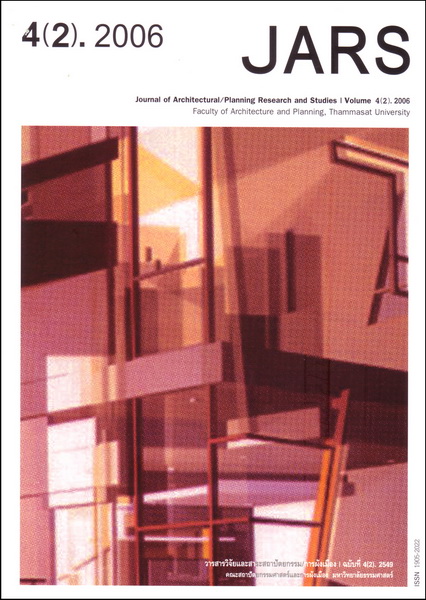Respiratory Diseases: The Fatal Risk Caused by Inappropriate Design & Operation of Office Buildings
Main Article Content
Abstract
This paper presents the study of risk caused by respiratory diseases, and proposes design and
operation guidelines for healthy office environments. The study includes respiratory diseases reviews and
data collection though observing and surveying of office buildings. The content is divided into three parts:
1) the information of the risk and spreading of respiratory diseases, 2) the outdoor and indoor environmental
factors which cause the germ contamination in building, and 3) the observing and surveying of eight office
environments to find the problem of design and operation.
It is discovered that contaminated buildings are caused by seven risk factors: 1) building materials
and furnishings that absorb moisture well, 2) spaces with small corners, 3) problem of moist indoor air, 4)
the lack of space for cleaning and maintenance, 5) problem of air conditioning system, 6) building energy
conservation policy, and 7) improper cleaning and maintenance method. This study also finds that another
significant factor that causes the germ contamination in buildings is an occupant’s behaviour. The results
lead to guidelines for designers, building managers, and users to create safe places from respiratory
diseases.
It is wished that this article would change the public attitudes in designing and managing architecture.
Quality of life should be more concerned aside from energy conservation, functional design, and occupants’
comfort.
Downloads
Article Details

This work is licensed under a Creative Commons Attribution-NonCommercial-NoDerivatives 4.0 International License.
All material is licensed under the terms of the Creative Commons Attribution 4.0 International (CC-BY-NC-ND 4.0) License, unless otherwise stated. As such, authors are free to share, copy, and redistribute the material in any medium or format. The authors must give appropriate credit, provide a link to the license, and indicate if changes were made. The authors may do so in any reasonable manner, but not in any way that suggests the licensor endorses you or your use. The authors may not use the material for commercial purposes. If the authors remix, transform, or build upon the material, they may not distribute the modified material, unless permission is obtained from JARS. Final, accepted versions of the paper may be posted on third party repositories, provided appropriate acknowledgement to the original source is clearly noted.
References
Ingraham, J. L., & Catherine, A. (2000). Introduction to microbiology (2nd ed.). USA: Brooks/Cole.
Maier, R. M. (2000). Environmental microbiology. Canada: Academic Press Publishing.
สุมาลี ชนะชาญมงคล และคณะ. (2544). อันตรายทางชีวภาพและโรคติดเชื้อจากการทำงาน (พิมพ์ครั้งที่ 1). กรุงเทพฯ: สำนักพิมพ์ บีไลน์ กราฟฟิค.
Kay, J. G., & others. (1991). Indoor air pollution: Radon, bioaerosols, & VOCs. USA: Lewis Publishers.
Kowalski, W. J. Airborne respiratory diseases and mechanical system for control of microbes. Retrieved from http://www.medicalairsolutions.com.
สมหวัง ด่านชัยวิจิตร. (2542). อิทธิพลของสภาพแวดล้อมต่อโรคติดเชื้อ. ตำราเวชศาสตร์สิ่งแวดล้อม. กรุงเทพฯ: สำนักพิมพ์ จอห์น พี ลอฟทัส, 907–923.
Mohr, A. J. (2002). Fate and transport of microorganisms in air. Manual of Environmental Microbiology. Washington, DC: ASM Press American Society for Microbiology.
Berlin, G. Humidity control, IAQ, and you. Retrieved from http://www.esmagazine.com.
ASHRAE. (2000). 2000 ASHRAE Handbook – HVAC Systems and equipment. Atlanta: American Society of Heating, Refrigerating and Air-conditioning Engineers.
Black, J. G. (1999). Microbiology principle and explorations (4th ed.). N. J.: Prentice Hall.
ทวี เวชพฤติ. การออกแบบระบบปรับอากาศและระบายอากาศกับคุณภาพอากาศในอาคาร. http://www.thaihvac.com.
ประนอม ภูวนัตตรัย และคณะ. สถานการณ์คุณภาพอากาศภายในอาคาร. http://www.env.anamai.moph.go.th/ develop/pdf/iaq.pdf.
สมาคมวิศวกรรมสถานแห่งประเทศไทย ในพระบรมราชูปถัมภ์ (2543). มาตรฐานระบบปรับอากาศและระบายอากาศ. กรุงเทพฯ: ส. เอเซียเพรส (1989).
ASHRAE. (2004). ANSI/ASHRAE Standard 62.1-2004. Atlanta: The American Society of Heating, Refrigerating and Air-conditioning Engineers.

